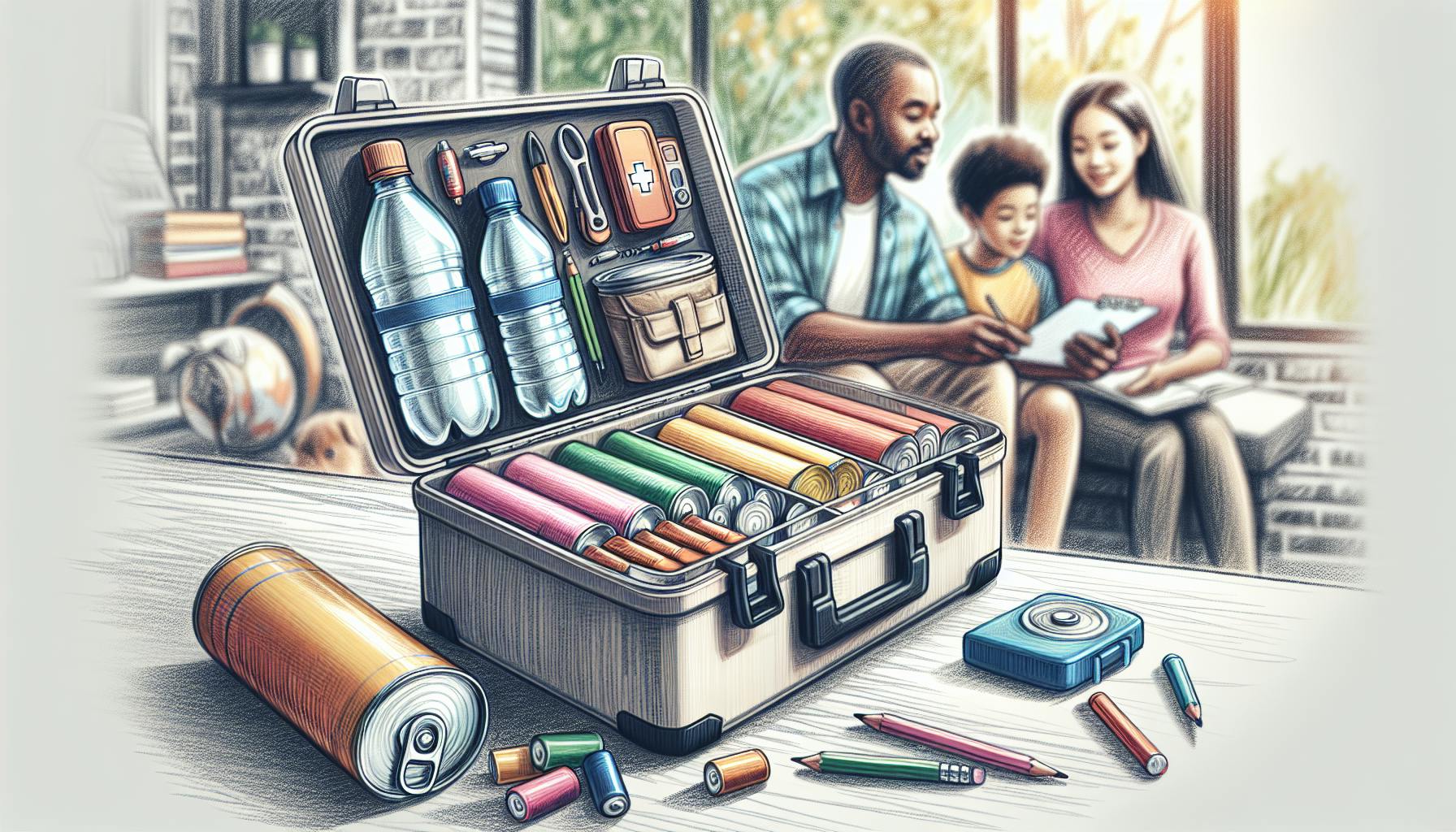Preparing for emergencies often means stockpiling shelf-stable foods.
Properly storing these foods can help maximize their shelf life and nutritional value when you need them most.
In this article, we'll cover best practices for food storage, including temperature control, preventing moisture damage, and keeping pests away.
Introduction to Best Survival Food Storage Practices
Proper food storage is critical for emergency preparedness. When storing food for survival situations, the key goals are to maximize shelf life, maintain nutritional value, and prevent waste.
Here are some best practices to keep in mind:
-
Store food in a cool, dark place. Temperature and light exposure impact how long foods last. Aim for storage around 40-50°F if possible.
-
Use airtight, food-grade containers. Preventing moisture and oxygen exposure will extend freshness. Glass and heavy plastic work well.
-
Organize by expiration date and rotate stock. Use older items first to avoid spoilage. Take inventory every 6 months.
-
Consider freeze-dried, dehydrated, and canned items. These preserve well long-term if stored properly in a pest-free area.
-
Supplement with Mylar bags, oxygen absorbers, etc. Additional preservation tools can drastically extend shelf life for some items.
Properly storing survival food takes some work but pays dividends when you need it most. Following these best practices will help you avoid waste while keeping essential nutrition on hand for emergencies.
What are the best long term storage survival foods?
Canned meats like tuna, chicken, and spam can last 2-5 years when properly stored, providing protein and nutrients. Rice, beans, lentils, and other dried grains are very long-lasting and nutritious staples. Some other good options include:
- Canned fruits and vegetables - store 2-5 years
- Canned soups and stews - store 2-5 years
- Pasta - keeps 8+ years if stored properly
- Instant mashed potatoes - lasts up to 30 years when sealed
- Honey - lasts indefinitely if kept sealed
- Hard cheeses like cheddar or parmesan - keeps several years when refrigerated
- Peanut butter - lasts 3-4 years unopened
- Nuts and trail mixes - lasts up to 2 years sealed
When building your long term food storage, focus on nutrient-dense non-perishables with a long shelf life. Canned and dried varieties are best for stockpiling. Be sure to store items properly by keeping cool, dry, and pest-free. Rotate and eat oldest items first, and check expiration dates regularly.
What is the best foods to store for doomsday?
Canned goods and shelf-stable foods are some of the best options for doomsday food storage. Here are some top foods to consider stockpiling:
- Canned fruits, vegetables, beans, meats, and fish - These provide essential nutrients and proteins. Opt for low-sodium varieties when possible.
- Canned soups and broths - Choose options that are not cream-based, as they have a shorter shelf life.
- Shelf-stable milk and juices - These come in handy for both drinking and cooking/baking purposes. Powdered milk is another good option.
- Honey - This has an indefinite shelf life and is packed with nutrients.
- Whole grains like rice, quinoa, pasta, oats, etc. - Properly stored in airtight containers, these can last 30 years or more.
- Freeze-dried and dehydrated fruits, vegetables, and meats - These maintain nutritional value and are lightweight.
- Nuts and trail mixes - High in protein and healthy fats. Store in cool, dark places to maximize freshness.
- Granola, protein, and fruit bars - These compact snacks provide an energy boost.
- Comfort foods like chocolate, coffee, tea, etc. - It's important for morale in tough times!
When building your doomsday food supply, focus on nutrient-dense non-perishable foods with long shelf lives, supplements to cover nutritional gaps, and some comfort items for morale. Practice first-in-first-out organization and periodically check expiration dates. With the right storage methods, many everyday foods can safely last years past their best-by dates. Proper planning is key to making it through a long-term crisis!
What is the best food to stockpile?
When building your emergency food supply, focus on nutrient-dense non-perishable foods with a long shelf life. Some of the best options to stockpile include:
-
Canned and dried meats: Canned varieties like tuna, chicken, salmon, and spam can provide protein. Look for low-sodium options when possible. Dried meats like beef jerky also store well.
-
Canned beans: Beans are packed with fiber, protein, and nutrients. Opt for low-sodium versions.
-
Canned fruits and vegetables: Fruits and veggies stored in cans, pouches, or jars are essential. Go for ones packed in juice rather than syrup when possible.
-
Whole grains: Properly stored white rice, oats, pasta, flour, and dry cereal can last for years. Keep in airtight containers.
-
Nuts and trail mixes: High in protein and healthy fats. Store in cool, dark places to maintain freshness.
-
Powdered milk and eggs: Reconstitute with water when needed for cooking and baking.
-
Water and electrolyte drinks: Aim to have at least 1 gallon stored per person per day. Rotate stock every 6 months.
No matter what foods you choose, be sure to check expiration dates, store items properly, and rotate stock to maximize freshness and shelf life. Building a varied emergency food supply takes some work, but it's essential for survival preparedness.
Does survival food really last 25 years?
Most survival food is designed to last for decades when properly stored. Here are some tips to help your food last as long as possible:
-
Choose foods processed for long term storage. Look for freeze-dried, dehydrated, canned, or retort pouched items which have had oxygen and moisture reduced to prevent spoilage.
-
Store food in a cool, dark, and dry place. Temperatures between 40-70°F are ideal. Use moisture absorbers and oxygen absorbers if available.
-
Inspect food and containers periodically for signs of spoilage like mold, rust, swelling or leaking. Discard anything questionable.
-
Follow all storage instructions on packaging. Some items may require refrigeration after opening.
-
Practice first in first out (FIFO) organization. Use up opened foods before unopened when possible.
-
Consider shelf life when buying survival food. Aim for 5-30 years shelf life depending on expected length of storage.
With proper planning and storage techniques, most commercially packaged survival food can retain safe nutritional value for decades, helping you build an emergency food supply to get through hard times.
sbb-itb-b932644
Essentials of an Emergency Preparedness Kit
When building an emergency preparedness kit, selecting foods with a long shelf life is critical for survival. Canned goods, dried foods, and freeze-dried meals are all good options that can last years when stored properly. Here are some best practices for choosing survival foods:
Selecting Foods That Last a Long Time
- Focus on non-perishable and canned items like beans, tuna, salmon, vegetables, fruits, soups, and stews. Opt for low-sodium varieties when possible.
- Dried goods like cereals, pasta, rice, grains, and baking mixes can last up to 30 years when stored in airtight containers. Prioritize whole grains and fortified options.
- Freeze-dried foods and MREs (Meals Ready to Eat) are lightweight and have a shelf life of 5-10 years. Mountain House and Wise Foods are reputable brands.
- No matter what you choose, always check expiration dates and continually rotate out food from your supply.
Creating and Storing an Emergency Water Supply
Having sufficient water during an emergency is vital. Here are some tips:
- Store at least 1 gallon of water per person per day for drinking and sanitation needs. Consider keeping a 2-4 week supply.
- Use food grade plastic containers with tight lids. Glass bottles can also work.
- Add water purification tablets to kill bacteria and viruses. A Lifestraw or Sawyer water filter also works.
- Replace water every 6 months to keep it fresh.
Including a Reliable Camp Stove and Water Filter
A camp stove and water filter enable cooking food and purifying water:
- Small propane or butane stoves are portable. Conserve fuel by boiling only the amount of water needed.
- Look for a filter that can remove bacteria, protozoa, and viruses. The Sawyer Squeeze and Lifestraw Personal filters are top choices.
- Store fuel canisters properly to avoid leaks or corrosion. Check seals and connections regularly.
Packaging and Organizing Your Emergency Supply Kit
- Use durable plastic bins or bags to hold all your gear. Backpacks also work for smaller kits.
- Pack food tightly together to maximize space. Separate cooking items from food.
- Place water, first aid supplies, lights, tools, and other critical items on top for easy access.
- Make smaller, transportable "grab and go" bags with 3-5 day supplies in case you must evacuate quickly.
Having the right food, water, and gear can mean the difference between life and death in an emergency. Invest in quality survival items and learn how to use them before disaster strikes.
Optimizing Shelf Life and Nutritional Value
Checking expiration dates regularly is crucial for maintaining a fresh and safe emergency food supply. Canned goods in particular can last for years when stored properly. Choose low-sodium canned options to promote better health. Keeping flour correctly stored in airtight containers will help extend its usability.
The Importance of Checking Expiration Dates
It's important to routinely check the expiration dates on your emergency food supplies. Out-of-date foods can spoil more quickly and lose nutritional value. Stored properly, most shelf-stable foods last 6 months to 2 years past their printed date. Canned goods may last even longer, but it's still wise to check dates periodically. As you replenish your stocks, move older items to the front to ensure first use.
Selecting Canned Varieties for Essential Nutrients
Canned foods like beans, tomatoes, tuna, and fruits can provide you with essential nutrients during an emergency. Seek low-sodium options when possible. Although sodium helps preserve canned goods, too much can lead to high blood pressure. Canned veggies like carrots, spinach, and sweet potatoes give you fiber, vitamins, and minerals your body needs. Canned protein sources like salmon, chicken, and chili ensure you get enough.
Choosing Low-Sodium Options
Choosing low-sodium canned goods provides health benefits for emergency situations. While sodium content helps preserve canned foods, too much sodium can increase blood pressure and stress your body. Seek canned veggies, beans, meats, and soups with "low sodium" or "no salt added" on the label. If regular canned goods are your only option, rinsing the contents before eating can reduce sodium content. Moderating portions is also wise.
Properly Stored Flour to Extend Usability
Storing flour correctly helps extend its shelf life for emergency use. Once opened, store flour in airtight containers like food grade plastic bins or mason jars. This prevents moisture absorption and insect infestations. Store containers in a cool, dark place like a pantry. Refrigeration can extend shelf life longer. Properly stored, unbleached white flour lasts 6-12 months. Check for musty odors or signs of bugs before using old flour. Freezing extends storage to 1-2 years.
Maintaining Food Safety During Power Outages
Learn how to keep foods fresh and safe during a power outage, ensuring your emergency food supply remains viable. Having a stockpile of survival food is crucial, but proper storage is key to preserving nutritional value and preventing spoilage. Follow these best practices for food safety during outages.
Safe Refrigerator Temperature for Food Safety
Keep refrigerator temperatures at or below 40°F to slow bacteria growth. Monitor temps with a appliance thermometer. If above 40°F for over 2 hours, discard perishable foods like meat, eggs, and leftovers.
Fruits and vegetables can be kept longer. Focus on eating them first after a power outage. Canned and shelf-stable foods are ideal for outages over 4 hours.
Frequently Asked Questions: Freezing
Can I refreeze thawed food? No. Bacteria multiplies quickly at 40° F or higher. Refreezing won't kill bacteria that started growing during thawing. Discard thawed perishables.
Is food still safe in a full freezer? Yes. A full freezer will keep food safe for 48 hours during an outage. A half-full freezer will keep food safe 24 hours. If unsure how long power was out, discard freezer items.
Utilizing Ice and Alternative Cooling Methods
Without power, use ice, insulated coolers, and cold storage to keep refrigerator temperatures low. Block ice lasts longer than cubes. Place perishable foods between layers of ice in a cooler or insulated container. Open infrequently.
You can also place shelf-stable canned goods or water bottles in the fridge/freezer to help maintain cold temps longer. Monitor temperatures with a thermometer and discard items if above 40°F for over 2 hours.
Preparing for Extended Power Outages
For outages lasting multiple days, focus on non-perishable survival foods with long shelf lives. Stock up on canned goods, powdered milk, cereal, jerky, and meal replacement shakes.
Have alternate cooking sources like camp stoves and grills. Keep a manual can opener, plates, and utensils. Having an emergency preparedness kit ready for disasters will ensure you can safely feed your family.
Recommended Survival Food Products to Stockpile
A curated list of specific food products and kits to consider for your emergency food storage. Having the right foods and supplies on hand can make a critical difference in an emergency situation where access to fresh food is limited. When building your stockpile, focus on nutrient-dense, non-perishable items with a long shelf life that meet your dietary needs. Useful products to include are:
ReadyWise Emergency Food Supply
The ReadyWise Emergency Food Supply offers a selection of freeze-dried entrees and breakfasts with a 25 year shelf life. The lightweight pouches are easy to transport and prepare by adding hot water. With vegetarian and gluten-free options, this kit provides balanced nutrition from whole ingredients.
Survive2Thrive Vegetarian Preparedness Pail
Perfect for vegetarians, the Survive2Thrive Pail contains 30 days worth of 100% plant-based food with a 15 year shelf life. Using a blend of grains, legumes and veggies, it offers complete protein and essential nutrients. The resealable pail protects against pests, water and light.
Mountain House Essential Bucket
Trusted for decades, Mountain House meals are known for their quality. The Essential Bucket provides a variety of made-to-order pouches that you just boil in water. With up to 30 years of shelf life, it's a reliable addition to your stockpile.
Good To-Go Emergency Food Kit
For lightweight and fast nutrition on-the-go, Good To-Go's kit contains a selection of dehydrated meals in recyclable pouches. They offer balanced nutrition and bold flavors like pad thai and herbed mushroom risotto that can be quickly prepared with hot water.
Augason Farms Emergency Supply Food Kit
With a diverse assortment of grains, breakfast items and entrées, this kit will feed a family for several days in an emergency. Mylar pouches block out moisture and oxygen to preserve freshness for up to 25 years. Gluten-free and vegetarian options available.
S.O.S. Rations Emergency Food Bars
Providing concentrated calories and nutrients, these non-thirst inducing food bars can sustain energy levels in tough situations. With a 5 year shelf life, they easily tuck into bags and emergency kits. Flavors like chocolate peanut butter are appetizing.
Momofuku Noodle Variety Pack
For an upgrade in flavor, Momofuku’s pack offers unique ramen recipes crafted by David Chang. Vacuum-sealed for freshness, the rich broths and noodles can be prepared easily with hot water during power outages.
Scout Smoked Wild Pink Salmon
Wild-caught pink salmon offers an excellent source of protein as well as omega-3 fatty acids and vitamin D. Scout's smoked filets have a 5 year shelf life. They make a tasty, nutritious addition to meals when fresh options are not available.
Protekt Hydration Supplements
Maintaining adequate hydration is critical in emergency scenarios. Protekt's electrolyte mixes help replenish fluids and prevent dehydration. With a 10 year shelf life, they take up little space but provide essential support.
Having the right selection of foods and supplies tailored to your needs is key to being prepared. Prioritize nutrient density, shelf life, packability and dietary accommodations when stocking up. Rotate and replenish items as you use them to ensure freshness.
Key Takeaways on Survival Food Storage
Properly storing your survival food is critical to ensure it lasts as long as possible while maintaining nutritional value. Here are the key takeaways:
-
Regulate temperature by storing food in a cool, dry place between 40°F and 70°F. Fluctuating temperatures can shorten shelf life.
-
Prevent moisture by using airtight, waterproof storage containers. Moisture causes mold, bacteria growth, and premature spoilage.
-
Manage pests by inspecting storage areas regularly and using sealed containers. Rodents and insects can contaminate food.
-
Check expiration dates and follow the First In, First Out (FIFO) system when stocking up on survival food. This ensures you rotate and use food before it expires.
-
Have an emergency plan for accessing your food if the power goes out for an extended time. Consider backup power sources to keep refrigerated/frozen foods from spoiling.
-
Conduct regular maintenance by inspecting all survival food for signs of spoilage, damage to packaging, etc. Properly re-seal or replace food as needed.
Storing survival food properly is vital to maximize shelf life. Following temperature, moisture, pest control, and maintenance best practices keeps food fresh, safe, and nutritious when you need it most.


